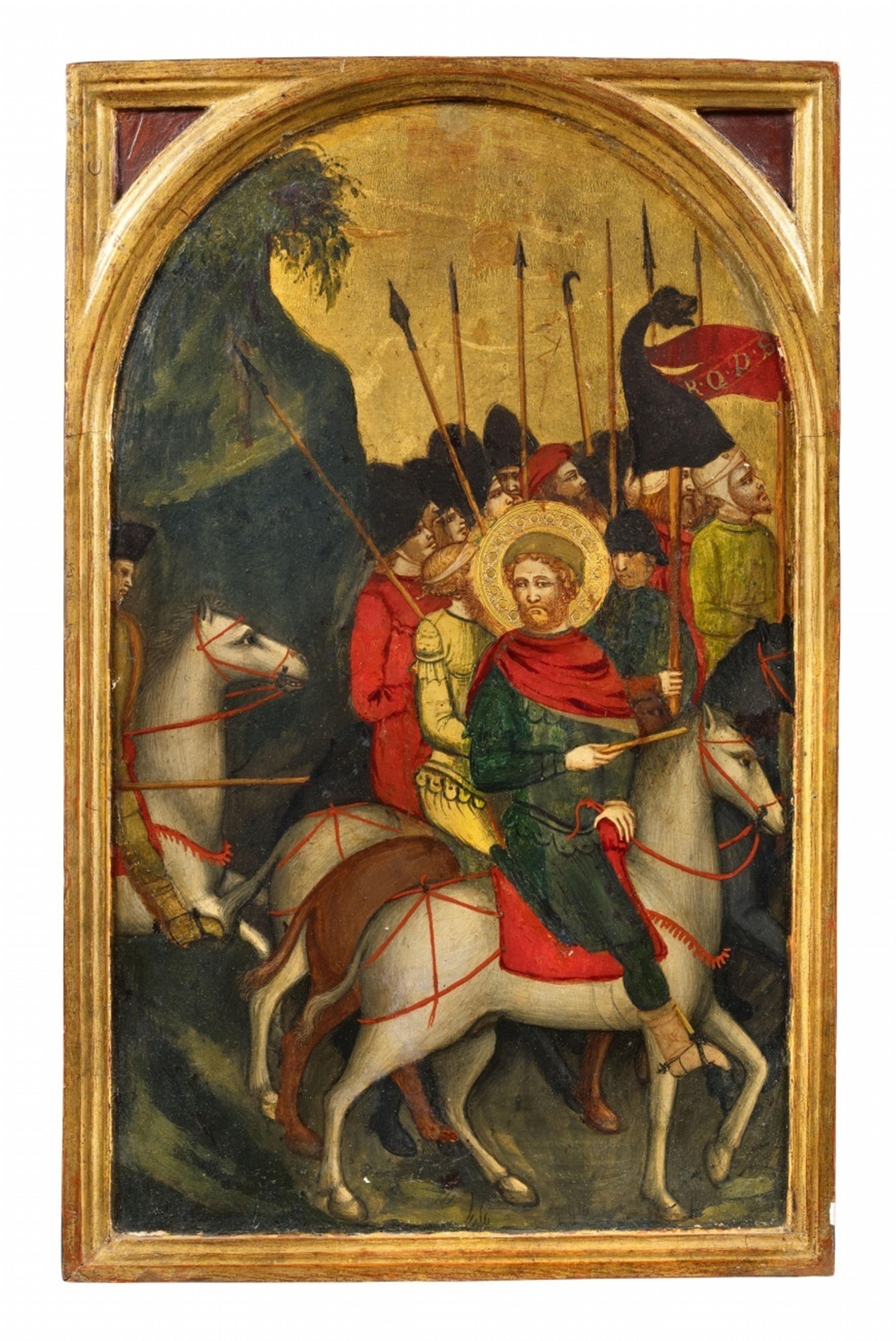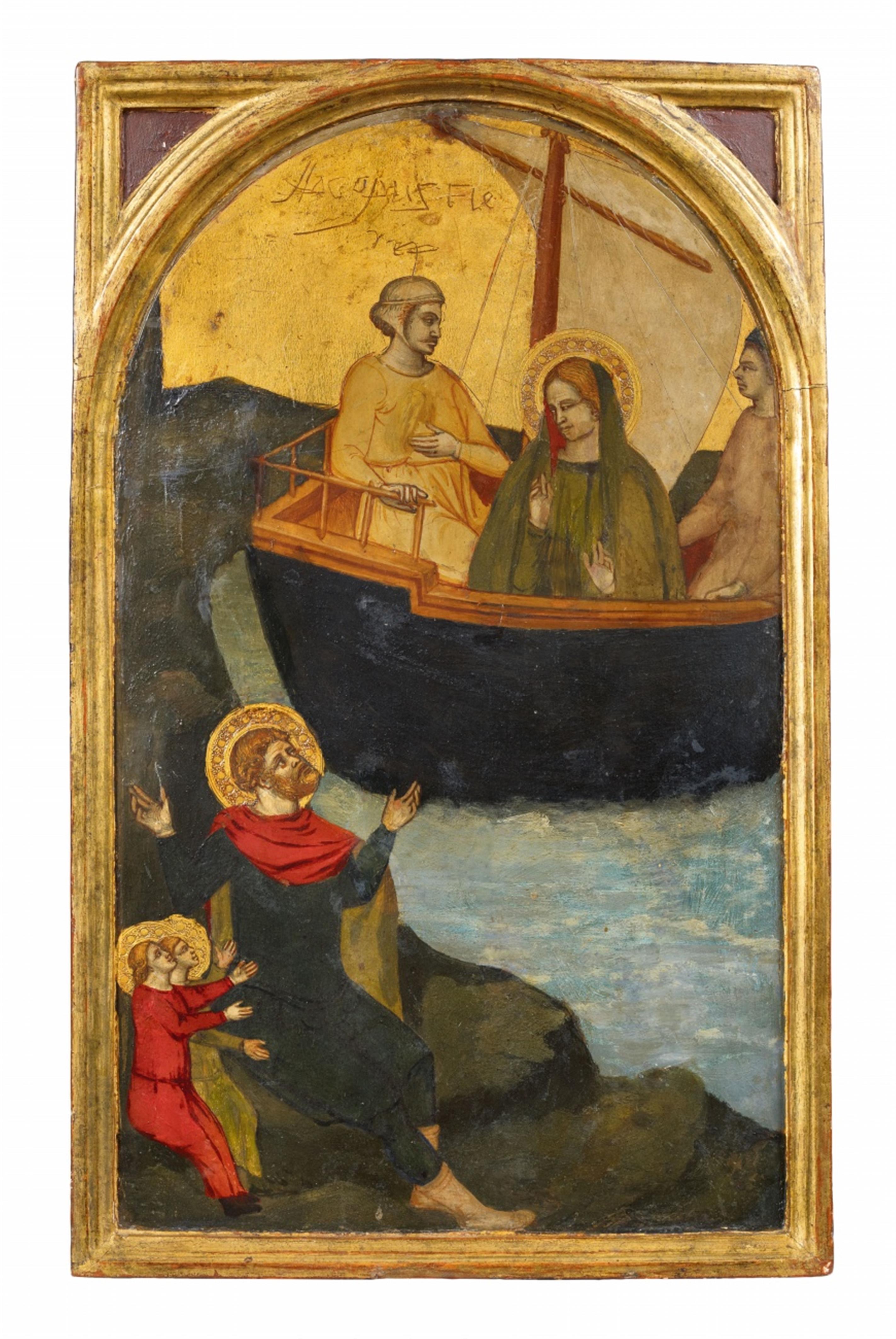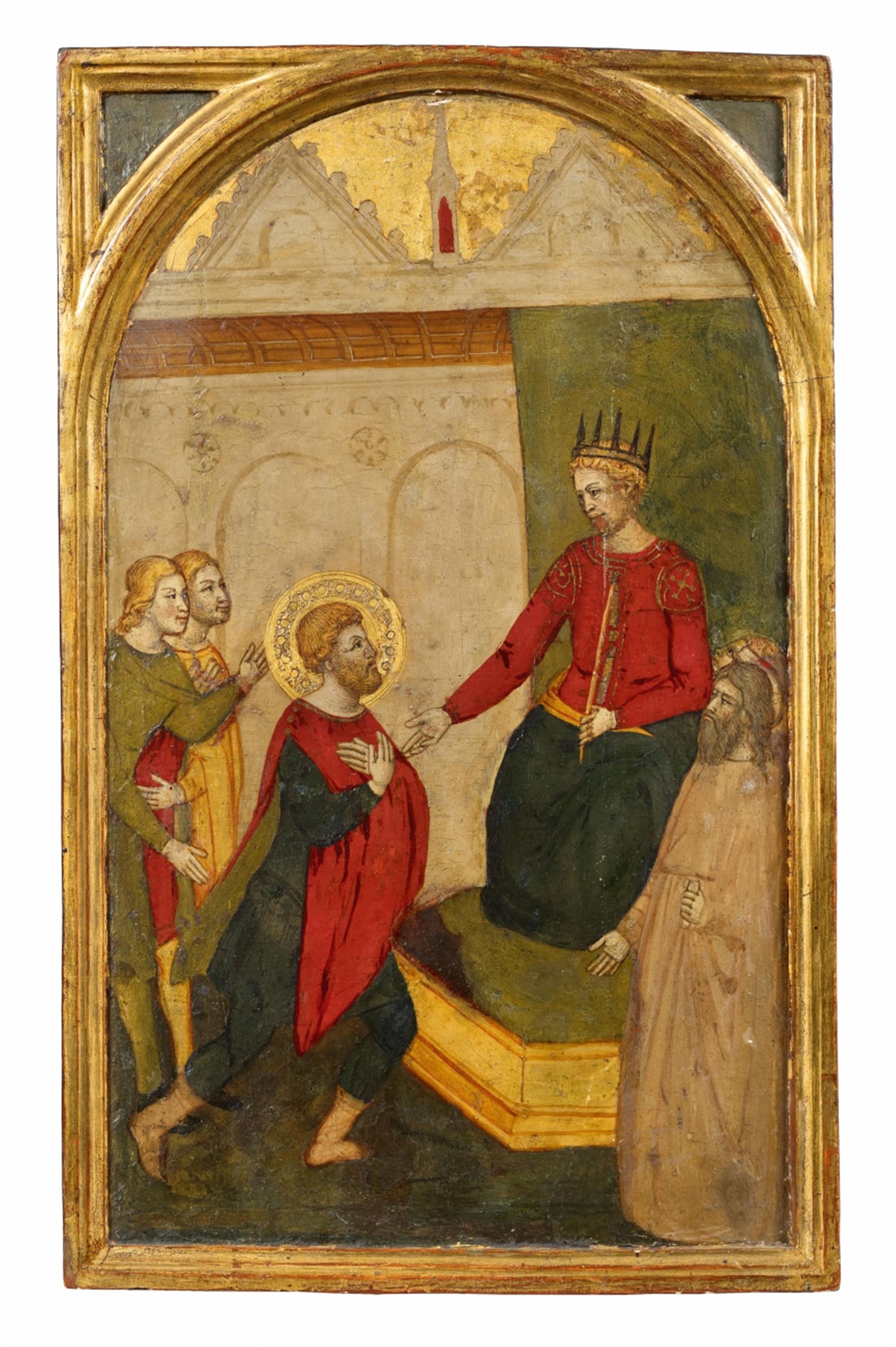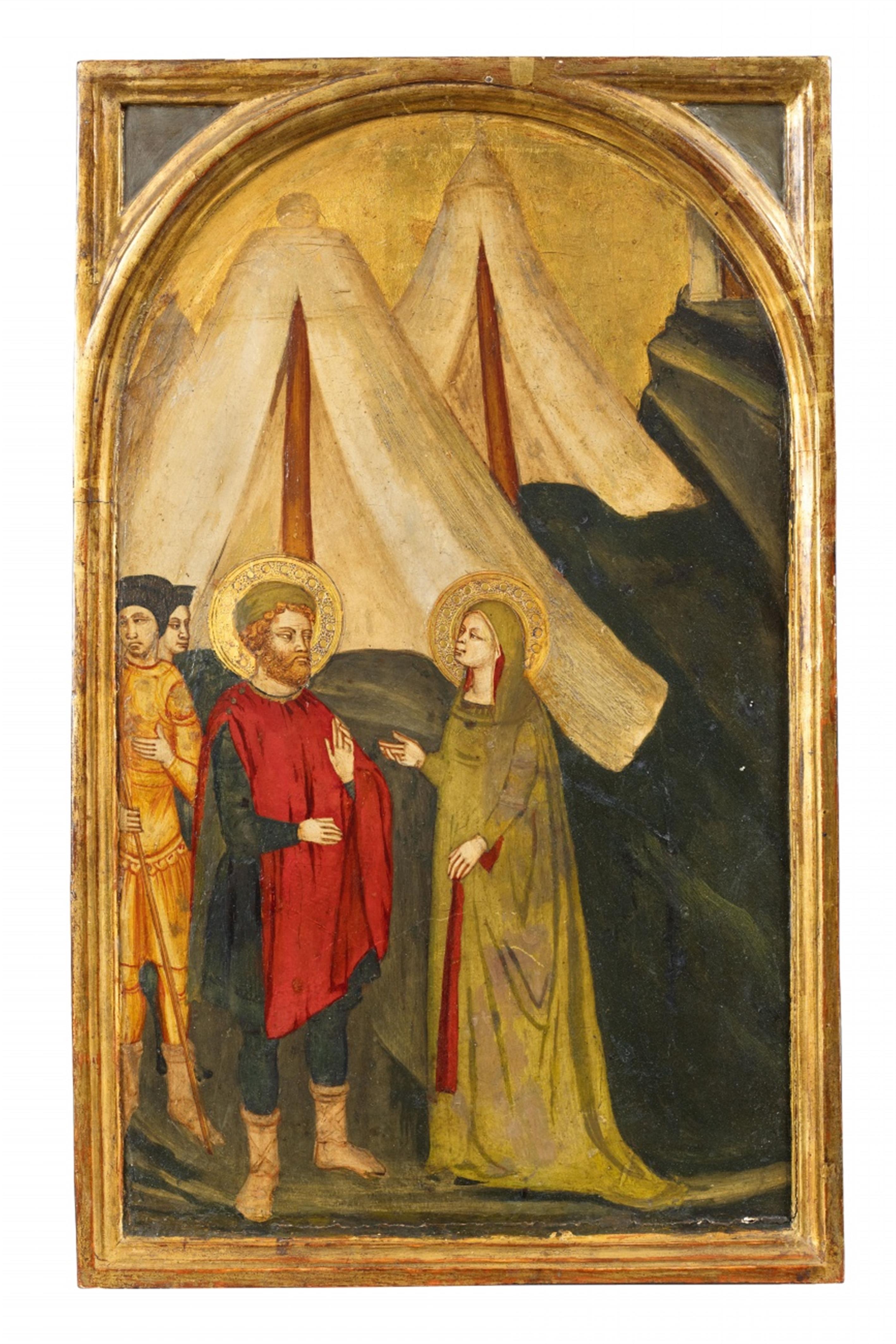Maestro di Campo Giove (Nicolo Olivieri della Pietranziera?)
Four Scenes from the Life of St. Eustace
Tempera on panel. Each 40 x 32 cm.
1. Eustace separated from his wife after arriving in Egypt, fleeing from the plaque
2. Emperor Trajan giving Eustace control of his troops
3. Eustace leading the troops to war
4. Eustace rediscovers his wife in his camp
These four panels with scenes from the life of St. Eustace originate from an altarpiece dedicated to this saint. Prior to their mysterious removal in October 1902, the pieces formed part of an elaborate folding altarpiece located in the Church of St. Eustace in the remote mountain village of Campo di Giove in the Abruzzo. The altar comprised two sets of eight painted scenes from the saint's life flanking a wooden sculpture depicting him.
Although the pieces were separated and remained scattered throughout the world for almost 120 years following a possible theft or sale by the village priest and sacristan, the lost altarpiece has remained fundamental for the understanding of the iconography of St. Eustace in Italy. It was included in Kaftal's repertoire of Tuscan hagiographical iconography in 1952, although its origin in Abruzzo was unknown at this point, and the piece was erroneously listed as a Tuscan product of the 14th century (Kaftal 1952, p. 356-360).
Most of the elements of the piece have appeared periodically on the art market during previous decades, and from there have entered various collections. The main section comprising five panels went to the Saibene collection in Milan (Nicoletti 2008), others returned to Abruzzo and are now kept in the Galleria Nazionale degli Abruzzi in Aquila, and others still can be found in private collections in Bergamo, France, Germany, and the United States. Only two panels depicting “Eustace looking into the river with his sons” and “Eustace and his family being thrown to the wild animals and remaining unharmed” have not yet been rediscovered. A detailed examination of the various twists and turns in the panels' history can be found in L.P. Nicoletti's publication from 2008.
The present four panels were discovered in the Kisters Collection after being kept in a private collection in Leipzig. They were auctioned once more in 1977, and subsequently disappeared once again until their current rediscovery. The four pieces recount episodes from the story of St. Eustace as recorded in the Legenda Aurea. The panels show the episodes taking place before sparse landscape backgrounds, with most of the figures placed far to the front and interacting in simple, lively gestures and expressions.
Contrary to older research opinions, Niccoletti (2008, 2014), Pasqualetti (2008, 2014), and Angelelli (2014) have convincingly attributed the work to a local Abruzzo master. The artist presumably developed his manner from that of the anonymous Maestro del Crocifisso d' Argento to create the hybrid style typical of this region. This combines Umbrian forms and Tuscan motifs from Assisi with local elements to create a unique pictorial language. The connection to Abruzzo was solidified by comparison with the frescoes of the life of St. Francis in Castelvecchio Subequo, which could also be convincingly ascribed to the same master as the St. Eustace panels (Angelelli 2014). In comparison to the graceful and dynamic figures in the panels, the frescoes exude a more harmonious and monumental atmosphere, in which the figures appear more sculptural. However, detailed examination of the figures, especially the faces, shows that both paintings originate from the same hand, as argued by Pasqualetti in 2014.
Recently, the polychromy of several sculptures has also been attributed to this painter. For example, a figure of Saint Nicholas in the Cloisters in New York, and further works such as a Virgin and Child from Campo di Giove housed in the Museo Civico Diocesano d'Arte Sacra in Sulmona. One of these pieces, the Virgin and Child from Campo di Giove in Sulmona, was supposedly also signed “Nicolo Olivieri della Pietranziera pinxit” according to an 18th century inscription (Pasqualetti 2014). This gives some clue as to the identity of the master of Campo di Giove. An inscription to the fresco cycle of the life of Saint Francis in the Cappella dei Conti di Celano at San Francesco in Castelvecchio Subequo, which dates the work's completion to December 1394, provides a time frame for the artist's career. The St. Eustace cycle was presumably also painted at around this period or possibly slightly earlier in the late 1380s.
We would like to thank Prof. Gaudenz Freuler for his kind support in cataloguing these works.
Provenance
Campo di Giove (Abruzzi), Chiesa di Sant´Eustachio. - Lost along with all other elements of the altar of St. Eustace in 1902. - Max v. Bleichert collection, Leipzig. - Auction „Sammlung Max v. Bleichert, Leipzig, Zweiter Teil, Kunstgewerbe / Gemälde Alter Meister“, Rudolph Lepke's Kunst-Auctions-Haus, Berlin, 9.-10.12.1931, lot 214 -217. - Heinz Kisters collection. - Continental private collection.
Literature
A. de Nino: Notizie degli Abruzzi. Una pittura rubata a Campodigiove (AQ), in L´Arte 5, 1902, p. 425-426. - P. Piccirilli: Notizie dagli Abruzzi, Opere d´arte in Campodigiove, in L´Arte 6, 1903, p. 210-217. - A. de Nino: Sommario dei monumenti e degli oggettid´arte, 1904, p. 16-17. - G. Kaftal: Iconography of the Saint in Tuscany, Florenz 1952, p. 356-360. - M. Eisenberg: A late Trecento Custodia with the life of St. Eustace, in. Studies in late Medieval and Renaissance paintings in honour of Millard Meiss. - I. Lavin e J. Plummer ed., New York 1977, I. p.143-151, II. p. 47-53. - L. P. Nicoletti: Maestro di Campo Giove, in Altri quaranta dipinti antichi dalla collezione Alberto Saibene, a cura di G. Agosti, 2008. p. 4-25, no. 1-5. - G. Pasqualetti: Da Campo di Giove a Castelvecchio Subequo, un nouvo protagonista della pittura del Trecento in Abruzzo, in Ritorno in Abruzzo. Le storie di S. Eustachio restituite dal Grand Rapids Art Museum, 2008, p. 7-18. - C. Pasqualetti: Scheda in S. O.S Arte dell´Abruzzo, una mostra per non dimenticare, 2010, p. 173-174. - L. P. Nicoletti: Sulle Trace della Custodia di Campo di Giove. Fortuna Critica e di Mercato dei Frammenti delle Storie di Sant.´Eustachio, in: C. Pasqualetti (ed.): La Via degli Abruzzi e le Arti nel Medioevo, 2014, p. 75-86. - W. Angelelli: Modi, Modelli e Moduli. Le Storie di San Francesco nella Capella dei Conti di Celano a Castelvecchio, in: C. Pasqualetti (ed.): La Via degli Abruzzie le Arti nel Medioevo, 2014. p. 87-116.








